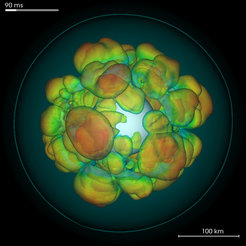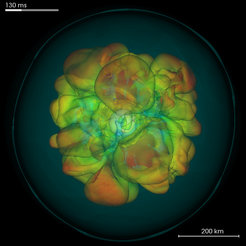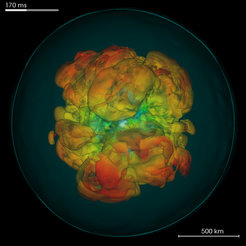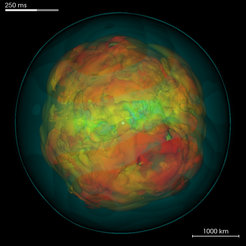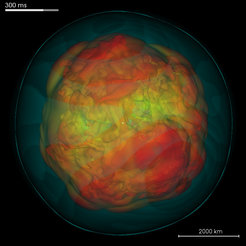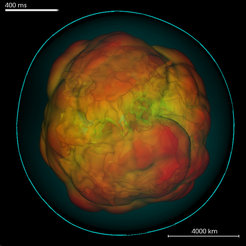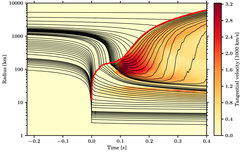The process to confirm this paradigm in detailed physical models, however, has been long: In the 1980s, the first star "exploded" in a computer, but only in spherically symmetric (i.e. one-dimensional) models and with some special assumptions to simplify the description of the physics involved. But the observation of supernova 1987A showed that multi-dimensional effects play an important role during the explosion. The shells surrounding the neutron star are mixed by convection, which further supports neutrino heating. After a few decades, scientists could confirm the basic functioning of the neutrino mechanism with two-dimensional models (see Press Release 2009). Still, the forced rotational symmetry about an arbitrary axis severely restricts motions of the stellar plasma. In addition, turbulent flows behave differently under these symmetry assumptions compared to three dimensions. It is therefore necessary to perform three-dimensional calculations to model all processes during the supernova correctly.
So far, simulations have not yielded successful explosions in three dimensions (Press Release 2013 und Highlight 2014). But now, the scientists obtained their long desired result: the first successful, neutrino-driven explosion of a star with an initial mass of 9.6 solar masses in a three-dimensional, self-consistent simulation (see Fig. 1). The challenge was to describe the neutrinos as correctly as possible, so that the resulting complex calculation kept even supercomputers busy for a few months. The new method provides the currently most complete description of how neutrinos interact with matter in a supernova calculation. In particular, there is an open, controversial question whether three-dimensional turbulence in the neutrino heated plasma helps or hinders the explosion.
In this case, the answer is definitely yes: three-dimensional turbulence leads to about 10% higher explosion energy. Turbulent effects in the heating layer change the flow of stellar material into the cooling layer, which means that the temperature in this region remains lower. As the cooling by neutrinos strongly depends on temperature, the energy loss by neutrino emission decreases at lower temperature and the explosion gets stronger. However, it is difficult to predict whether this phenomenon could play an equally important role for even more massive stars. To answer this question, the scientists need further simulations. They also plan to calculate the explosion with even higher resolution to better resolve turbulence and investigate it on smaller scales. Another important question is whether the star might have been asymmetric before collapse and how this would affect the explosion. So even with this significant milestone, the astrophysicists still have some way to go.
Tobias Melson, Hans-Thomas Janka
Public outreach: Hannelore Hämmerle
